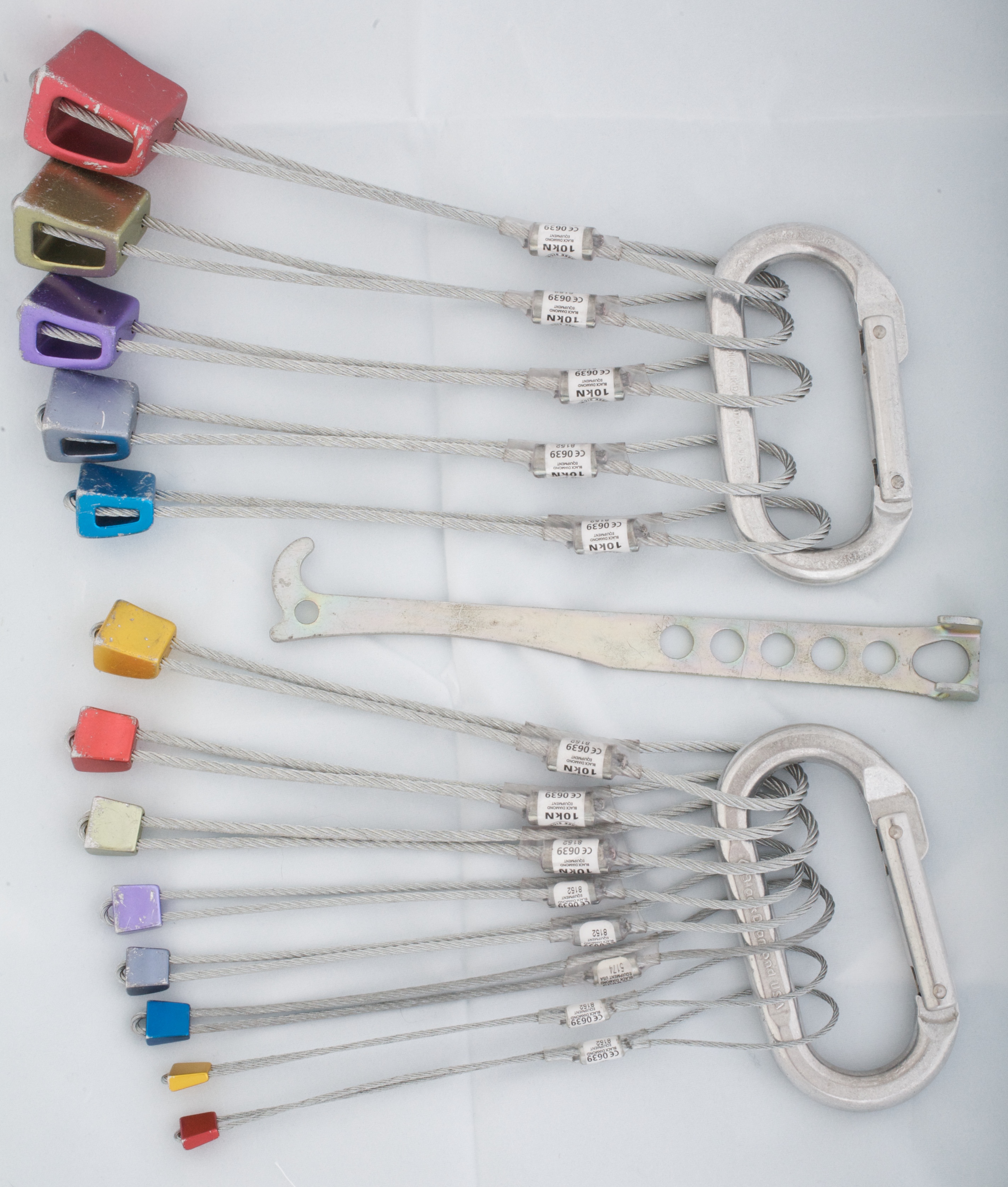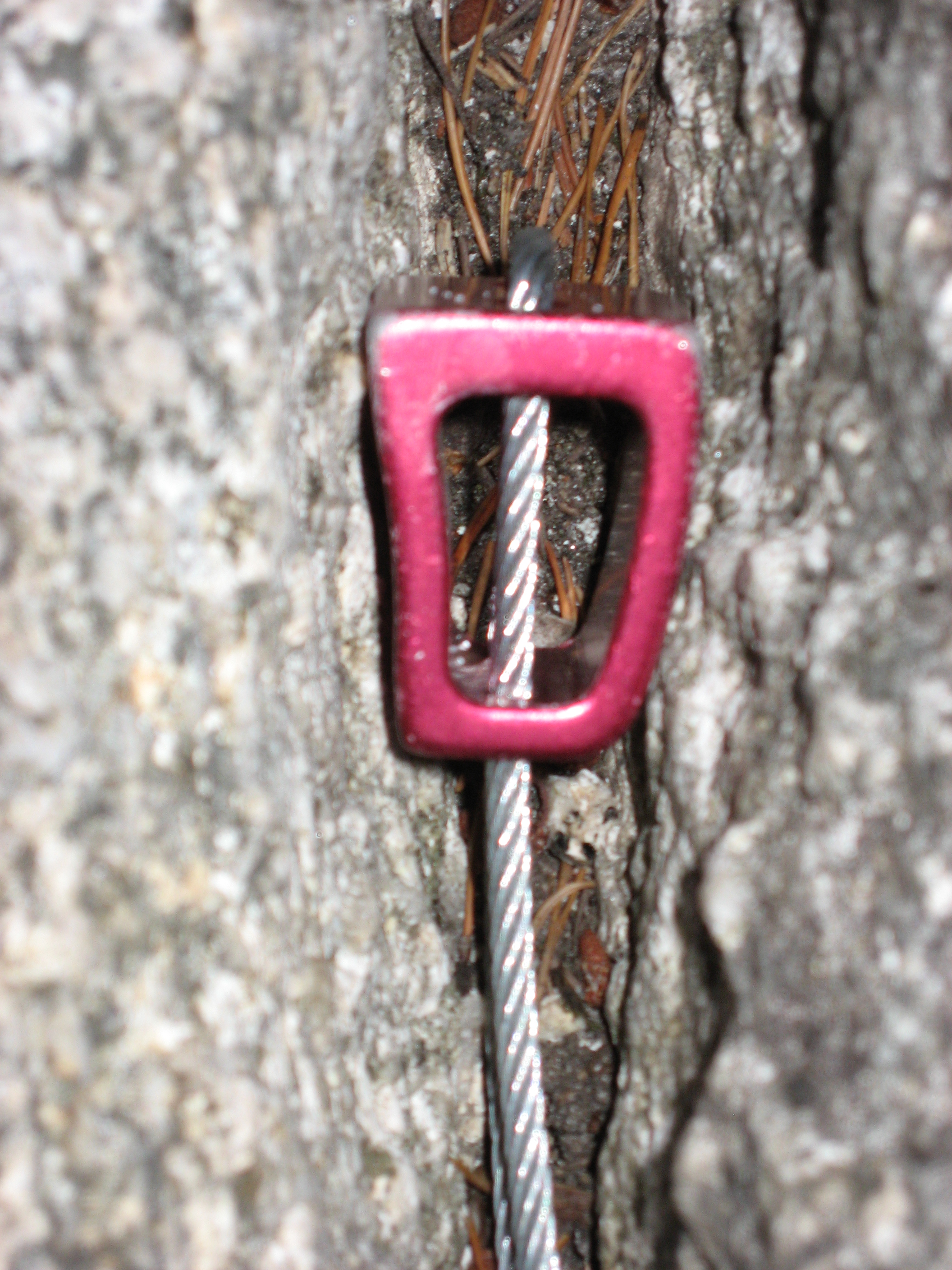Nut (climbing) on:
[Wikipedia]
[Google]
[Amazon]
 In rock climbing, a nut (or ''chock'' or ''chockstone'') is a metal wedge threaded on a wire that climbers use for
In rock climbing, a nut (or ''chock'' or ''chockstone'') is a metal wedge threaded on a wire that climbers use for  Nuts or chockstones are named after natural stones occasionally found wedged into cracks. Climbers eventually realized they could insert their own found pebble into a suitable crack. In an article called "Artificial Aids in Mountaineering" dated Oct-Dec 1956, G Sutton wrote about jammed knots for direct aid. He also compared the use of slings, chocks (rocks) and jammed knots to artificial climbing (aid climbing) and that "there should be no illusion that the use of a chockstone is in any way more admirable than that of a piton."
By 1967
Nuts or chockstones are named after natural stones occasionally found wedged into cracks. Climbers eventually realized they could insert their own found pebble into a suitable crack. In an article called "Artificial Aids in Mountaineering" dated Oct-Dec 1956, G Sutton wrote about jammed knots for direct aid. He also compared the use of slings, chocks (rocks) and jammed knots to artificial climbing (aid climbing) and that "there should be no illusion that the use of a chockstone is in any way more admirable than that of a piton."
By 1967  Nuts may be generically referred to as ''wires'' or ''stoppers'', though "Stopper" is a brand name of a nut made by
Nuts may be generically referred to as ''wires'' or ''stoppers'', though "Stopper" is a brand name of a nut made by
 In rock climbing, a nut (or ''chock'' or ''chockstone'') is a metal wedge threaded on a wire that climbers use for
In rock climbing, a nut (or ''chock'' or ''chockstone'') is a metal wedge threaded on a wire that climbers use for protection
Protection is any measure taken to guard a thing against damage caused by outside forces. Protection can be provided to physical objects, including organisms, to systems, and to intangible things like civil and political rights. Although th ...
by wedging it into a crack in the rock. Quickdraws are clipped to the nut wire by the ascending climber and the rope threads through the quickdraw. Nuts come in a variety of sizes and styles, and several different brands are made by competing manufacturers. Most nuts are made of aluminum
Aluminium (aluminum in American and Canadian English) is a chemical element with the symbol Al and atomic number 13. Aluminium has a density lower than those of other common metals, at approximately one third that of steel. It ha ...
. Larger nuts may be threaded on Dyneema
Ultra-high-molecular-weight polyethylene (UHMWPE, UHMW) is a subset of the thermoplastic polyethylene. Also known as high-modulus polyethylene, (HMPE), it has extremely long chains, with a molecular mass usually between 3.5 and 7.5 million amu. T ...
cord instead of wire, but this has become unusual.
The very smallest nuts are known as ''micronuts'' and may be made of brass
Brass is an alloy of copper (Cu) and zinc (Zn), in proportions which can be varied to achieve different mechanical, electrical, and chemical properties. It is a substitutional alloy: atoms of the two constituents may replace each other wit ...
or other metal, and typically have their wires solder
Solder (; NA: ) is a fusible metal alloy used to create a permanent bond between metal workpieces. Solder is melted in order to wet the parts of the joint, where it adheres to and connects the pieces after cooling. Metals or alloys suitable ...
ed into them, instead of looped through drilled holes. They are mostly used in aid climbing, and their value as protection, arresting a climber's fall, is marginal because of both their low breaking strength and their tiny surface area (the HB 0 measures about 4 x 7 x 2.5 mm) in contact with the rock, though this can be offset if several are placed at a time. Other names used include ''RPs'' (the brand name of the first commercially available micronuts) and ''brassies''. They are available from several manufacturers in a variety of styles.
British climbers in the 1950s and 1960s were the first to use nuts as climbing protection. In addition to using pitons, they picked up machine nuts from the side of railway tracks, climbed with them in their pockets, and used them as artificial chocks. This developed to the point where they drilled the thread from the middle, threaded them with slings, and used them in cracks.
 Nuts or chockstones are named after natural stones occasionally found wedged into cracks. Climbers eventually realized they could insert their own found pebble into a suitable crack. In an article called "Artificial Aids in Mountaineering" dated Oct-Dec 1956, G Sutton wrote about jammed knots for direct aid. He also compared the use of slings, chocks (rocks) and jammed knots to artificial climbing (aid climbing) and that "there should be no illusion that the use of a chockstone is in any way more admirable than that of a piton."
By 1967
Nuts or chockstones are named after natural stones occasionally found wedged into cracks. Climbers eventually realized they could insert their own found pebble into a suitable crack. In an article called "Artificial Aids in Mountaineering" dated Oct-Dec 1956, G Sutton wrote about jammed knots for direct aid. He also compared the use of slings, chocks (rocks) and jammed knots to artificial climbing (aid climbing) and that "there should be no illusion that the use of a chockstone is in any way more admirable than that of a piton."
By 1967 Royal Robbins
Royal Robbins (February 3, 1935 – March 14, 2017) was one of the pioneers of American rock climbing. After learning to climb at Tahquitz Rock, he went on to make first ascents of many big wall routes in Yosemite. As an early proponent of bol ...
saw the need for clean climbing and put up Nutcracker, an all nut protected 6 pitch climb, on the Manure Pile(Ranger Rock),Yosemite. In 1972, when clean climbing
Clean climbing is rock climbing techniques and equipment which climbers use in order to avoid damage to the rock. These techniques date at least in part from the 1920s and earlier in England, but the term itself may have emerged in about 1970 du ...
became an issue in the US, Yvon Chouinard
Yvon Chouinard (born November 9, 1938) is an American rock climber, environmentalist, philanthropist and outdoor industry businessman. His company, Patagonia, is known for its commitment to protecting the environment.
Chouinard is also a surf ...
began manufacturing chocks made specifically for rock climbing, with the familiar wedge shape still in use today. With Tom Frost
Thomas "Tom" M. Frost (June 30, 1936 – August 24, 2018) was an American rock climber known for big wall climbing first ascents in Yosemite Valley. He was also a photographer and climbing equipment manufacturer. Frost was born in Hollywood, Cal ...
, Chouinard invented a larger, six-sided nut called a Hexentric or hex. Prominent climbers like Henry Barber and John Stannard helped popularize the use of nuts, especially after it was discovered that a nut was lighter and easier to place and remove while climbing, as well as being at least as secure as a well-placed piton, and less damaging to the rock.
Nuts are available in different shapes to help the climber find the best fit for a given crack. Curved nuts have a concave face on one side and a convex face on the other. Larger nuts can be placed in either of two aspects (hexes in three aspects) to suit different-width cracks, with either the main faces or the sides in contact with the rock.
 Nuts may be generically referred to as ''wires'' or ''stoppers'', though "Stopper" is a brand name of a nut made by
Nuts may be generically referred to as ''wires'' or ''stoppers'', though "Stopper" is a brand name of a nut made by Black Diamond Equipment
Black Diamond Equipment is a manufacturer of equipment for climbing, skiing, and mountain sports, based in Utah, United States. The company also has a global office in Innsbruck, Austria. The company is owned by Clarus Corporation, which also o ...
.
References
{{Climbing-nav Nuts Mountaineering equipment